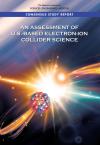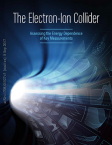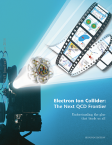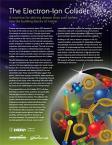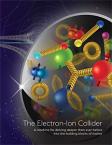JEFFERSON LAB SEARCH
-
Marcy Stutzman has been named a fellow of the American Vacuum Society
NEWPORT NEWS, VA – Some of the most advanced work to enable research at the U.S. Department of Energy’s Thomas Jefferson National Accelerator Facility is focused on ensuring that nothing gets in the way of the electron beam produced for nuclear physics experiments. Now, one Jefferson Lab staff scientist is being honored for her work on producing ultra-high to extreme-high vacuum environments to do just that.
-
Ten graduate students have been awarded fellowships to conduct research at Jefferson Lab by Jefferson Sciences Associates
-
A graduate student from Old Dominion University has received a supplemental research award to conduct research at Jefferson Lab
NEWPORT NEWS, VA – A graduate student who will work with theorists at the U.S. Department of Energy’s Thomas Jefferson National Accelerator Facility to better understand subatomic particles has received a supplemental research award from the DOE Office of Science Graduate Student Research Program.
-
The American Physical Society’s newly released list of 2020 Fellows includes two staff scientists and three others who have conducted or collaborated on research at Jefferson Lab
NEWPORT NEWS, VA – Five researchers who are affiliated with the U.S. Department of Energy’s Thomas Jefferson National Accelerator Facility have been selected by their professional peers for the distinct honor of Fellow of the American Physical Society.
News
Status
More information about the status of an electron-ion collider can be found in the documents linked below. In 2018, the National Academies of Sciences, Engineering and Medicine issued a report, “An Assessment of U.S.-Based Electron-Ion Collider Science.” Following the report, the directors of Thomas Jefferson National Accelerator Facility and Brookhaven National Laboratory issued a joint statement of support. More information about the impetus for building an electron-ion collider can be found in the 2015 Long-Range Plan, issued by the Nuclear Science Advisory Committee..
Benefits

Beyond sparking scientific discoveries in a new frontier of fundamental physics, an Electron-Ion Collider will trigger technological breakthroughs that have broad-ranging impacts on human health and national challenges. Research on the technologies needed to make this machine a reality is already pushing the evolution of magnets and other particle accelerator components.
Some of these advances could lead to energy-efficient accelerators, thereby dramatically shrinking the size and operating costs of accelerators used across science and industry for example, to make and test computer chips; to deliver energetic particle beams to zap cancer cells; to study and design improved sustainable energy technologies such as solar cells, batteries, and catalysts; and to develop new kinds of drugs and other medical treatments. New methods of particle detection developed for an EIC could also lead to advances in medical imaging and national security.
In truth, it’s nearly impossible to predict what will come from the knowledge gained from an EIC. History shows that applications springing from a deeper understanding of matter and fundamental forces things like GPS, microelectronics, and radiological techniques for diagnosing and treating disease often emerge many years after the foundational physics discoveries that make them possible.
But one thing is certain: Building the experiments that inspire and train the next generation of scientific explorers is essential for maintaining U.S. leadership in nuclear science and for developing the high-tech workforce needed to address some of our nation’s deepest challenges.Design

The Electron-Ion Collider would consist of two intersecting accelerators, one producing an intense beam of electrons, the other a beam of either protons or heavier atomic nuclei, which are then steered into head-on collisions.
The accelerators will be designed so that both beams can be polarized to around 70 percent for electrons, protons and light nuclei. Electrons will be able to probe particles from protons to the heaviest stable nuclei at a very wide range of energies, starting from 20–100 billion electron-volts (GeV), upgradable to approximately 140 GeV, to produce images of the particles’ interiors at higher and higher resolution. At least one detector and possibly more would analyze thousands of particle collisions per second, amassing the data required to tease out the smallest effects required for significant discoveries.
Building the EIC will require the same core expertise that led to the versatility of the polarized proton and heavy ion beams at the Relativistic Heavy Ion Collider (RHIC) at Brookhaven National Laboratory, and the unique polarized electron beam properties of the Continuous Electron Beam Accelerator Facility (CEBAF) at Thomas Jefferson National Accelerator Facility. These two Department of Energy laboratories have been collaborating on initial studies and developing designs that make use of key existing infrastructure and capitalize on investments in science and technology. Each design approach would require the development of innovative accelerator and detector technologies to answer the questions described in this brochure.
Goals
There are many scientific questions that researchers expect an Electron-Ion Collider will allow them to answer. Among them are four main topics of study.
 3D Structure of Protons and NucleiScientists would use the Electron-Ion Collider to take three-dimensional precision snapshots of the internal structure of protons and atomic nuclei. As they pierce through the larger particles, the high-energy electrons will interact with the internal microcosm to reveal unprecedented details—zooming in beyond the simplistic structure of three valence quarks bound by a mysterious force. Recent experiments indicate that gluons—the glue-like carriers of the strong nuclear force that binds quarks together—multiply and appear to linger within particles accelerated close to the speed of light, and play a significant role in establishing key properties of protons and nuclear matter. By taking images at a range of energies, an EIC will reveal features of this “ocean” of gluons and the “sea” of quark-antiquark pairs that form when gluons split—allowing scientists to map out the particles’ distribution and movement within protons and nuclei, similar to the way medical imaging technologies construct 3D dynamic images of the brain. These studies may help reveal how the energy of the massless gluons is transformed through Einstein’s famous equation, E=mc2, to generate most of the mass of visible matter.
3D Structure of Protons and NucleiScientists would use the Electron-Ion Collider to take three-dimensional precision snapshots of the internal structure of protons and atomic nuclei. As they pierce through the larger particles, the high-energy electrons will interact with the internal microcosm to reveal unprecedented details—zooming in beyond the simplistic structure of three valence quarks bound by a mysterious force. Recent experiments indicate that gluons—the glue-like carriers of the strong nuclear force that binds quarks together—multiply and appear to linger within particles accelerated close to the speed of light, and play a significant role in establishing key properties of protons and nuclear matter. By taking images at a range of energies, an EIC will reveal features of this “ocean” of gluons and the “sea” of quark-antiquark pairs that form when gluons split—allowing scientists to map out the particles’ distribution and movement within protons and nuclei, similar to the way medical imaging technologies construct 3D dynamic images of the brain. These studies may help reveal how the energy of the massless gluons is transformed through Einstein’s famous equation, E=mc2, to generate most of the mass of visible matter. Solving the Mystery of Proton SpinThe Electron-Ion Collider would be the world’s first polarized electron-proton collider where both the electron and proton beams have their spins aligned in a controllable way. This polarization makes it possible to make precision measurements of how a proton’s constituent quarks and gluons and their interactions contribute to the proton’s intrinsic angular momentum, or spin. Spin influences the proton’s optical, electrical, and magnetic characteristics and makes technologies such as MRI scanning work, but its origin has eluded physicists ever since experiments in the 1980s revealed that quarks can account for only about a third of the total spin. More recent experiments show that gluons make a significant contribution, perhaps even more than the quarks. An Electron-Ion Collider would produce definitive measurements of the gluons’ contributions, including how their movements within the proton microcosm affect its overall spin structure—thus providing the final pieces needed to solve this longstanding puzzle.
Solving the Mystery of Proton SpinThe Electron-Ion Collider would be the world’s first polarized electron-proton collider where both the electron and proton beams have their spins aligned in a controllable way. This polarization makes it possible to make precision measurements of how a proton’s constituent quarks and gluons and their interactions contribute to the proton’s intrinsic angular momentum, or spin. Spin influences the proton’s optical, electrical, and magnetic characteristics and makes technologies such as MRI scanning work, but its origin has eluded physicists ever since experiments in the 1980s revealed that quarks can account for only about a third of the total spin. More recent experiments show that gluons make a significant contribution, perhaps even more than the quarks. An Electron-Ion Collider would produce definitive measurements of the gluons’ contributions, including how their movements within the proton microcosm affect its overall spin structure—thus providing the final pieces needed to solve this longstanding puzzle. Search for SaturationCapturing the dynamic action of gluons within protons and nuclei will give scientists a way to test their understanding of these particles’ ephemeral properties. As gluons flit in and out of the vacuum, multiplying and recombining, scientists suspect they may reach a steady state of saturation called a “color glass condensate.” This unique form of nuclear matter gets its name from the “color” charges that mediate the interactions of the strong nuclear force, and the dense, glasslike walls these particles are thought to form in nuclei accelerated to nearly the speed of light, seemingly suspended by the effects of time dilation. Scientists will use the Electron-Ion Collider to search for definitive proof of whether this form of matter exists, and test the limits of gluons’ ability to expand beyond the bounds of a single proton/ neutron inside a nucleus. They’ll also explore the mechanism that keeps gluon growth in check, like a lid clamping down on an overflowing popcorn pot. Precisely measuring the strength of the gluon fields, which constitute the strongest fields found in nature, will tell us how gluons interact with each other and how they contribute to building the bulk of visible matter in the universe today.
Search for SaturationCapturing the dynamic action of gluons within protons and nuclei will give scientists a way to test their understanding of these particles’ ephemeral properties. As gluons flit in and out of the vacuum, multiplying and recombining, scientists suspect they may reach a steady state of saturation called a “color glass condensate.” This unique form of nuclear matter gets its name from the “color” charges that mediate the interactions of the strong nuclear force, and the dense, glasslike walls these particles are thought to form in nuclei accelerated to nearly the speed of light, seemingly suspended by the effects of time dilation. Scientists will use the Electron-Ion Collider to search for definitive proof of whether this form of matter exists, and test the limits of gluons’ ability to expand beyond the bounds of a single proton/ neutron inside a nucleus. They’ll also explore the mechanism that keeps gluon growth in check, like a lid clamping down on an overflowing popcorn pot. Precisely measuring the strength of the gluon fields, which constitute the strongest fields found in nature, will tell us how gluons interact with each other and how they contribute to building the bulk of visible matter in the universe today. Quark and Gluon ConfinementExperiments at an EIC would offer novel insight into why quarks or gluons can never be observed in isolation, but must transform into and remain confined within protons and nuclei. The EIC—with its unique combinations of high beam energies and intensities—would cast fresh light into quark and gluon confinement, a key puzzle in the Standard Model of physics.
Quark and Gluon ConfinementExperiments at an EIC would offer novel insight into why quarks or gluons can never be observed in isolation, but must transform into and remain confined within protons and nuclei. The EIC—with its unique combinations of high beam energies and intensities—would cast fresh light into quark and gluon confinement, a key puzzle in the Standard Model of physics.About
The Electron-Ion Collider is a proposed machine for delving deeper than ever before into the building blocks of matter, so that we may better understand the matter within us and its role in the universe around us.
Learn more about this first-of-its-kind machine in the documents linked below.





